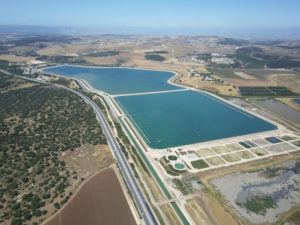
You have read this week about the troubles facing Jackson, Mississippi right now. Residents have been told not to drink the water after the city’s water treatment facility failed. But Jackson isn’t the first place to face a water crisis. Much of America is experiencing drought right now, and much of the world’s water security is tenuous all year round. One place where water has always been a concern is Israel. The country’s arid climate makes water security difficult to come by. But the country has taken concrete steps to bolster its supplies of water, and to use water more efficiently. In response to a recent article in The Wall Street Journal on the current spate of droughts around the world, Prof. S. Abraham Ravid of Yeshiva University explained Israel’s progress, writing:
“Droughts Take Widening Toll on World’s Largest Economies” (Page One, Aug. 22) highlights the effect of droughts around the world. It is time to change our view of water from that of an overabundant cheap resource to a commodity that needs to be produced and recycled.
When I was growing up in Israel, water shortages were a significant, ever-present issue, and there was even talk of regional wars over water resources. Today, Israel recycles about 90% of its wastewater (as do some other countries in the Middle East), and desalination is widespread. More than 50% of the water Israel consumes is artificially produced, it exports water to Jordan, and has become a world leader in water-efficient irrigation.
On the website, Israel21c.org, Max Kaplan-Zantopp dives deeper into the details of how Israel went from a country with chronic water shortages, to a country that now produces 20% more water than it needs. He writes:
Israel’s leadership in sustainable water management began with finding solutions to the country’s first and foremost problem: the uneven distribution of freshwater throughout the country –– an issue that Zionist thinker Theodor Herzl recognized in his 1902 book Altneuland with a “fantasy plan” to transport water great distances.
That fantasy began morphing into reality soon after Israel declared its independence in 1948 as waves of new immigrants lacked sufficient water for drinking and farming.
To supply the growing demand, Israel’s national water company Mekorot, began constructing the National Water Carrier.
This water transportation network was designed to pump water from the northern Lake Kinneret (Sea of Galilee) and transfer water from existing regional water projects to central and southern Israel.
But upon its completion in 1964, 80% of the water transported by this system was allocated for agriculture. Clearly, the National Water Carrier alone could not satisfy both agriculture and household needs.
Luckily, a solution was already in development thanks to the innovative genius of Simcha Blass and his son Yeshayahu, who began developing a drip irrigation technology in 1959. Their revolutionary method slowly applies water directly to the roots of crops through a network of tubes, valves and drippers.
Because this delivery method avoids the full brunt of evaporation, plants absorb 95 percent of the water applied to them – much more than sprinkler irrigation, surface irrigation or flood irrigation. With drip irrigation, less water could be allocated to farms without compromising agricultural output.
By 1965, the year following the completion of the National Water Carrier, Blass and his son began distributing their novel drip irrigation system throughout Israel and established Netafim, still a world leader in the field.
Today, drip irrigation waters 75% of Israel’s crops, but only 5% of farms worldwide currently utilize the technology due to financial barriers.
Using the unusable
Despite the transportive advantages of the National Water Carrier and the conservation benefits of drip irrigation, both innovations drew water solely from Israel’s very limited freshwater sources, which were being pumped faster than they could be naturally replenished.
Plus, the share of freshwater devoted to agriculture still vastly outweighed the amount allocated for drinking. By the mid-80s, agriculture was using 72% of Israel’s safe water supply.
Israeli engineers realized it’s not just about conserving available freshwater but also taking advantage of water sources previously considered unusable, such as treated municipal wastewater and stormwater.
In 1985, Israel began sending treated, recycled wastewater through its National Water Carrier to farms, greatly reducing the gap between consumer demand and available water.
This is because wastewater from our sinks, showers and toilets is not dependent upon climate fluctuations or seasonal weather patterns, but rather on population growth and living standards.
By 2015, Israel had managed to treat and recycle 86% of its wastewater for agricultural operations, leading the world in wastewater reclamation. Second to Israel in that same year was Spain, recycling just 17% of its wastewater.
Through Israel’s tertiary treatment processes, recycled wastewater is cleaned to near drinking-quality levels before reaching crops to avoid contamination.
The goal is to recycle 95% of wastewater for agriculture by 2025, leaving that much more fresh drinking water for the communities that need it.
Action Line: Your Survival Guy wants you to work hard to expand your family’s water security. Begin your efforts by downloading my free special report Emergency Water Storage: How Much, Containers, Purification & More. Then, read my follow-up report, WATER SECURITY: How to Save Rainwater Effectively to improve water security for your garden food supply.



